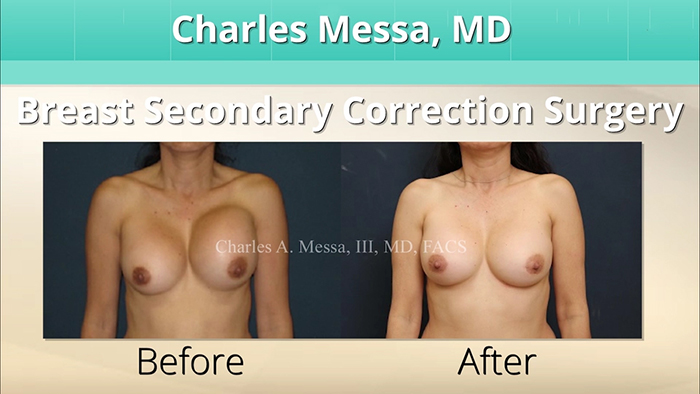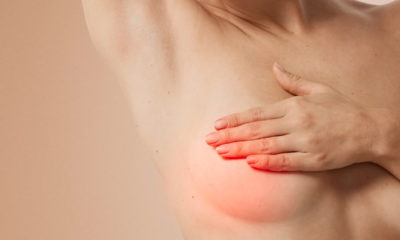One dead giveaway of a breast augmentation is a breast that feels hard to the touch. Why is it that some implants seem to become hard over time? And how can it be prevented from happening?
“After breast augmentation surgery, patients go through a period of time where their breasts are swollen,” explains board certified plastic surgeon Dr. Charles Messa of Florida. “It’s inflamed, so it might feel a little firmer. The skin is tight, the muscle is tight. That’s a normal part of the healing. However, after a period of months or even years after the procedure, if one or both breasts becomes increasingly firm to the point where it actually changes shape, or becomes painful, that’s called capsular contracture.”
What Is Capsular Contracture?
When breast implants are placed, the body heals by forming a thin layer of scar tissue, called a capsule, around each implant. In most cases, the patient is never even aware of the scar tissue. The breasts feel natural and soft. In these women, the scar tissue capsule remains thin and flexible around the implant.
In approximately one out of ten breast augmentation patients, the scar tissue tightens around the implant and becomes abnormally thick. As the scar tissue constricts around the implant, the result is an implant that feels firm. When this happens, it is known as capsular contracture.
“Capsular contracture, unfortunately, is a complication that can occur in any patient who has breast augmentation,” continues Dr. Messa. “It comes about because of infection. It’s not an overt infection – it’s not redness, it’s not fever. Instead, it’s a microscopic contamination of the surface of the implant that shows up as increased scarring.”
Understanding the Cause: Biofilm
When an implant is exposed to bacteria at the time of surgery, some of that bacteria may attach itself to the implant. When bacteria clings to the surface of an implant, forming a sticky coating around it, it is called biofilm. Biofilm is thought to be the main cause of capsular contracture.
Studies have shown that reducing the exposure of an implant to bacteria greatly minimizes the risk of capsular contracture. “So, what we try to do is eliminate or diminish the risk of any kind of microscopic bacteria, bacteria we call biofilm, forming on the surface of the implant,” explains Messa. Here follows 5 key steps used, at minimum, to reduce the risk during surgery.
#1: Use Nipple Shields to Prevent Bacterial Contamination
Bacteria are present in your gut, on your skin, and anywhere else where there is a channel connecting the outside world to the inside of your body. In fact, one area on the body where a lot of bacteria naturally reside is your nipples. During breast surgery, expert breast surgeons keep the nipples covered with nipple shields to prevent the bacteria present on the nipples from coming in contact with the implant.
#2: Insert Implant Through Crease Below Breast
While there are several locations commonly used to insert breast implants, the preferred incision location to reduce bacterial contamination is known as the inframammary fold.
The inframammary fold is located in the crease below the breast tissue. When an implant is inserted from below the breast tissue, there is less chance of it coming in contact with any bacteria present in the ducts of the breast tissue or the nipple
#3: Oral Antibiotics
“Another thing we do is give patients antibiotics before we start, so it’s in the bloodstream,” says Messa. The antibiotics find and kill bacteria that are present in the body, further reducing the chance of bacteria being present to attach to the implant as the body heals.
#4: Antibiotic Irrigation
In addition to the oral antibiotics, Dr. Messa also uses an antibiotic wash during surgery. “I also like to use antibiotics combined with an antiseptic solution called betadine to wash the implant and also wash the inside of the pocket where the implant is going to be sitting,” adds Messa.
#5: Keller Funnel/No Touch Technique
Similar to a frosting sleeve used by pastry chefs to decorate a cake, Dr. Messa uses a tool called a Keller Funnel to insert an implant into the breast pocket without allowing the implant to come in contact with the skin on the outside of the body. “It propels the implant into the pocket and eliminates the chance of the surface of the implant to actually be touched by the surrounding skin or the actual breast tissue,” says Messa. “We call that a no-touch technique.”
Find a Surgeon You Trust
While there are many steps a surgeon can take to reduce the chance developing capsular contracture, it can still happen. “It’s important to be aware of the potential problem and to make sure that your surgeon is doing everything they possibly can to reduce it from happening,” concludes Dr. Messa.


















Facebook
Twitter
Instagram
YouTube
RSS